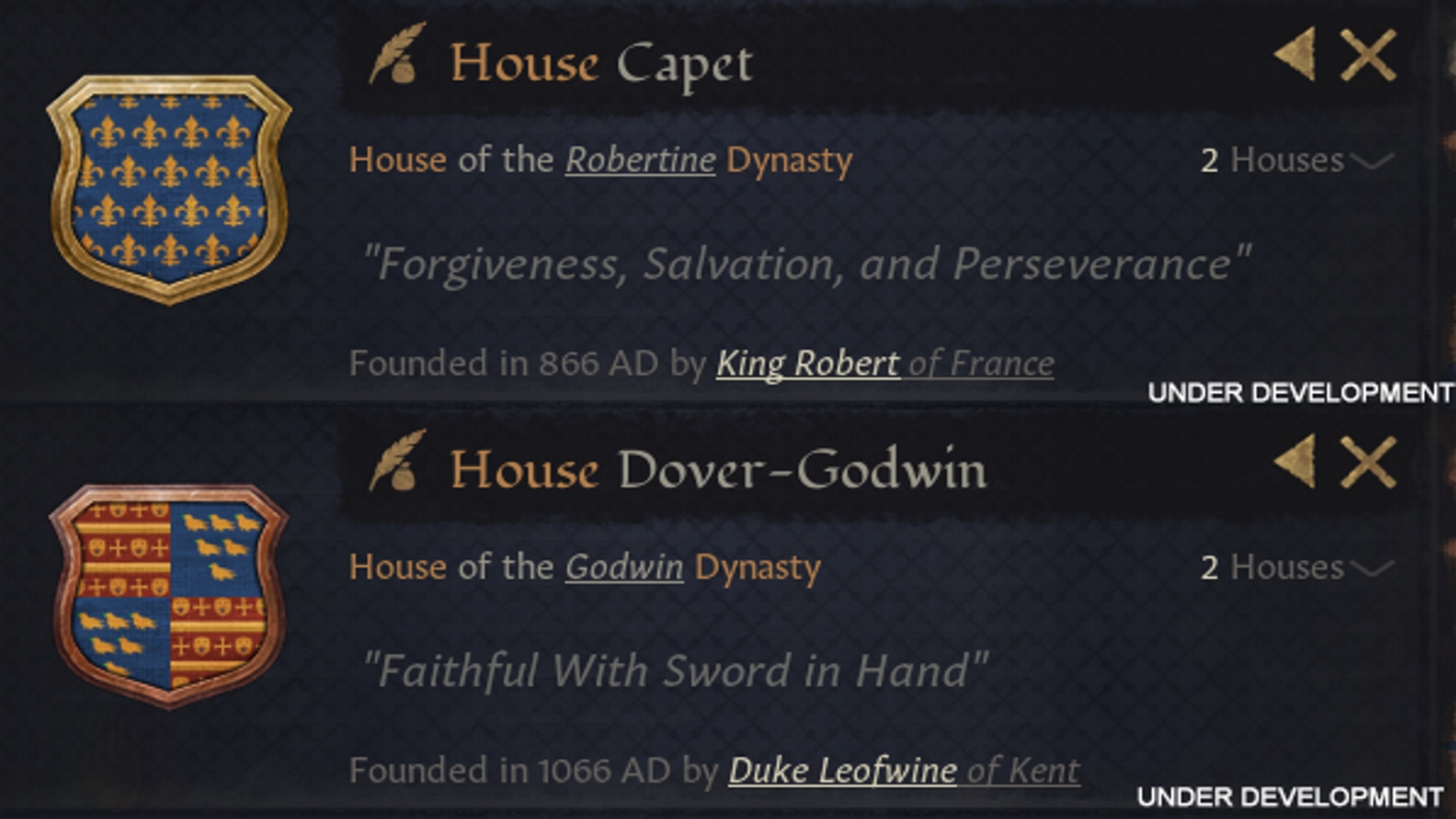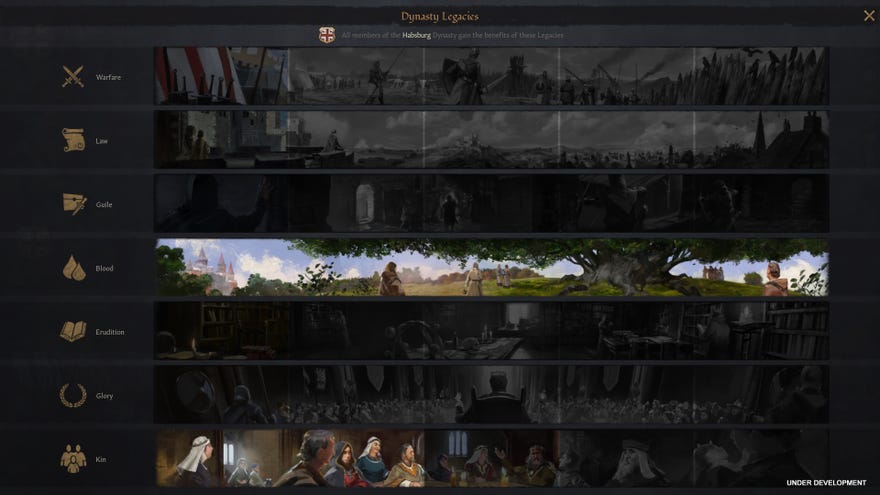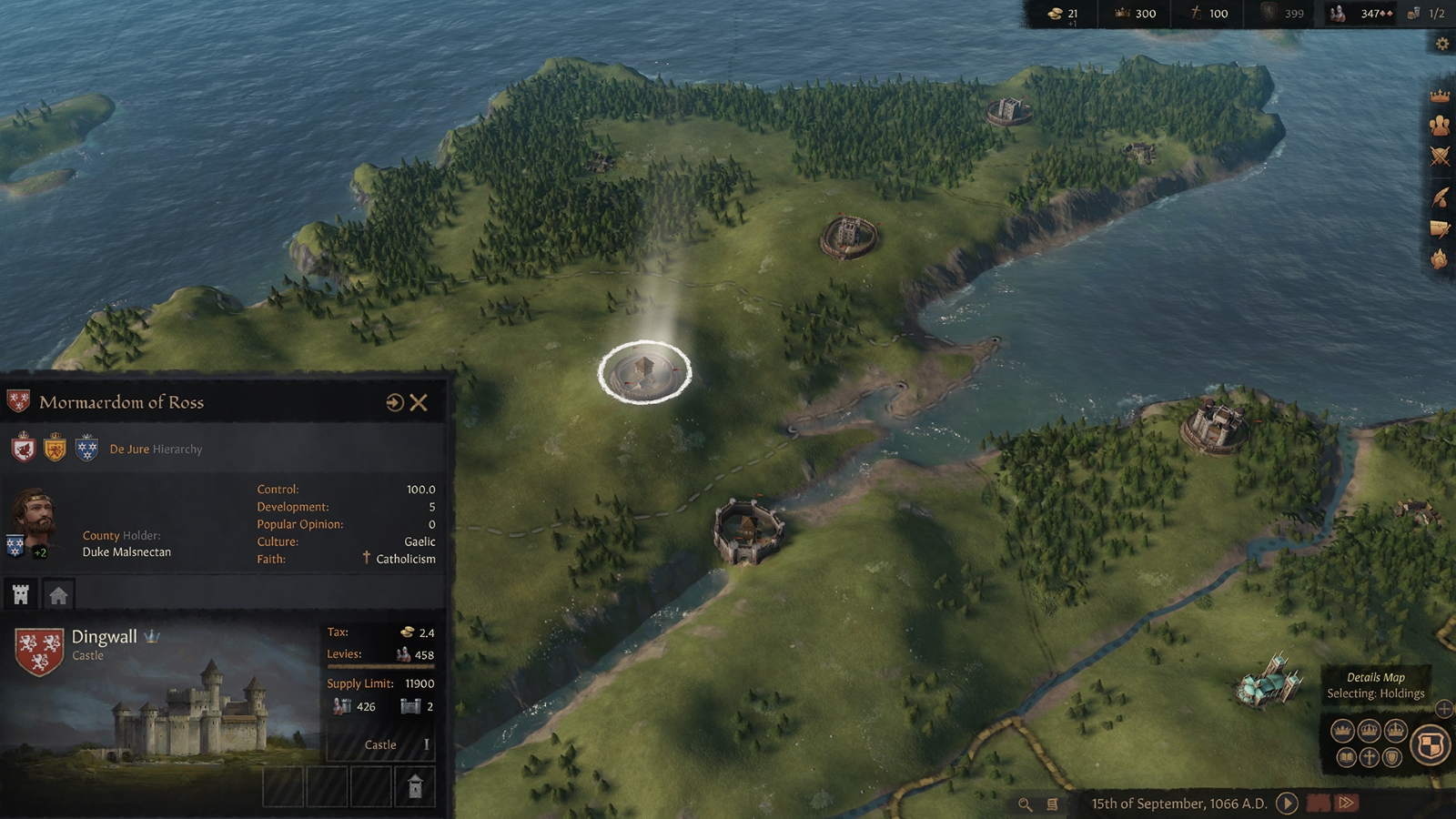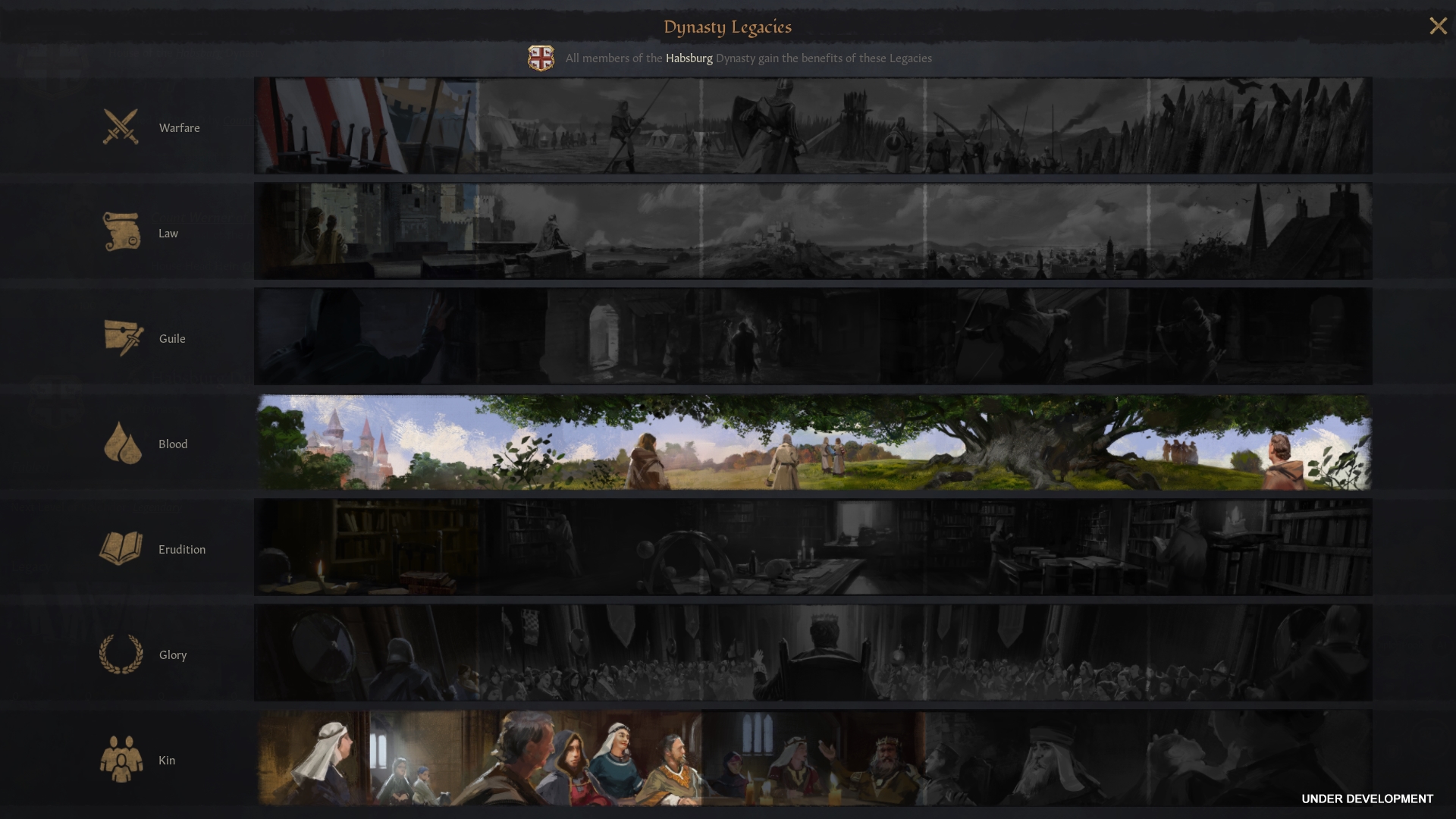Crusader Kings 3 is basically a Game of Thrones RPG in disguise
Beware negative splendor
The Crusader Kings franchise has always had a massive Game of Thrones vibe. Indeed, the first two games in the series got their own Westeros mods, and our own Adam Smith called CK2’s “such a blindingly obvious combination of worlds and mechanics that it simply had to exist”. Now, however, looking into the new dynasty mechanics for Crusader Kings 3, it’s clear what Paradox are doing: they’re basically putting that stuff in from day one.
OK, it’s still a historical game, so there’ll be work for modders in adding maps, character names and probably dragons. But in terms of feuding cadet houses, bastard offshoots and needlessly intense family mottos -- not to mention the new ‘Dread’ mechanic, wherein the more of a monster you are, the more your vassals are scared to disobey you -- you can have it all. There’s still plenty about CK3 to be revealed, but while we wait for flaying and seventy-seven course meals to be confirmed as features, here’s everything we know about the new dynasty system.
By the way, did you know that Paradox came reasonably close to making a GoT grand strategy game in the mid-2000s? Talking to former CEO Fredrik Wester last month, I learned that in the studio’s early days, it was mandatory for new hires to read the first three books in George RR Martin’s bloated series (“but they could skip the fourth,” Wester clarifies, “as it wasn’t very good”), and the GoT mod for Crusader Kings 1 was a huge hit internally.

Such was the team’s enthusiasm, in fact, that Wester sent a copy of CK1 to Martin in New Mexico in 2005, and spoke with his agent, Kay McCauley, about making a licensed game. Unfortunately, due to family circumstances, Wester had to postpone the discussion, and by the time it was resumed, the rights for the books were being sold to HBO. “Excessive violence, full frontal nudity and cursing?,” Wester remembers thinking at the time. “Good luck with that on prime time TV! But then, I suppose that’s why I’m not in broadcasting.”
So, anyway. Dynasties. As I wrote in last month’s preview, Crusader Kings 3 is Paradox’s attempt to build a “Grand RPG” game, and a central part of this is the fact that while you’ll still play as a sequential line of individual rulers, you’ll also be roleplaying as their dynasty in an overarching metagame through the centuries.
It all starts with Renown. This is a new resource, representing the overall coherence and solidity of your dynasty (that is, how much influence its dynast, or leader - usually the player character - has over its many branches), which is passively generated for you by every ruler within your dynasty that isn’t a subject under another member of your dynasty. Kings generate more than barons, and so on and so on.
In practice, this means you want to get as many family members as possible into positions of power in other countries. In a big departure from CK2, therefore, you’ll now have a good reason to take an interest in marrying off cousins and the like, other than to secure alliances or create complex schemes to off them and inherit their titles.
But what can you do with Renown? Well, for a start, it creates Splendor, a characteristic representing how cool your dynasty seems to everyone else, and which affects things including the prestige values your scions are born with, the prestige gained from marrying into your dynasty, your chances of success when arranging marriages, and the maximum opinion bonuses you can get from having a long reign. It even makes your Coat of Arms image look fancier and fancier, presumably as sycophants weld golden eagles and bunches of grapes onto it in an effort to get a pat on the head from you. Peasant dynasties, brilliantly, have Negative Splendor, which apart from anything else sounds like a great name for an Iain M Banks starship.
But you can also spend Renown - and if you do, your Splendor won’t decrease. Think of it as a golden ball that rises on the water of your renown, but is then held aloft by cherubs if the water recedes. You can spend Renown on two things: conducting powerful dynast interactions, such as claim-getting and disinheriting, and unlocking dynasty legacies.
Let’s start with dynasty legacies. Here’s some artwork for the seven different legacy tracks, which you’ll gradually colourise from left to right as you put points in them.
On this screen, you’ll get to gradually shape what your dynasty is known for, and ensure a permanent contribution to your long game that will last even when your current ruler is shanked by a bishop or pushed into a well by a horse or something. In Paradox’s words, “These aim to represent notions the world had or has about certain dynasties, i.e. that the Seljuks are warriors, the Abbasids lawmakers, the Habsburgs diplomats and, ahem, prone to marrying their own kin.”
There’re five unlocks on each of the seven tracks, and each costs progressively more Renown to unlock. In the Blood track, which seems to be everyone’s favourite, the first unlocks are about upping the “inheritance, emergence and reinforcement” of genetic traits, before moving on to reduce the odds of negative traits being passed on (something which is more likely in situations of, you guessed it, incest). The penultimate unlock lets you choose a particular trait to be more common among your kin -- there are loads to choose from, but the only one I care about is Giant, as I want to make Big Knights -- while the final unlock increases dynastic life expectancy and fertility.
To get that far, however, will be a proper mission. Legacies take ages to unlock, apparently, and you’ll be lucky to fill a track even as the ruler of a fairly prestigious dynasty.

Now let’s look at the other thing you can spend Renown on - dynast interactions. To understand these, it’s worth reiterating what a dynasty actually is in CK3. It’s not the single, lumpen family tree it was in CK2, but a collection of cadet branches (houses, essentially), each with their own coat of arms, their own identities, their own mottos, and their own priorities, but all working (theoretically at least) towards increasing the Renown of their overarching dynasty.
This is where it gets properly Thronesy, as Martin’s books were full of this stuff. For a good example of a cadet branch, think of the Karstarks, the offshoot of Sean Bean’s clan of wolf-toting Yorkshiremen, who got so good at driving cars they decided to make their own house based on it. They weren’t great at spelling, mind. As for real world examples, Paradox have suggested that “if a ruler of the Jimena Dynasty would create a cadet branch in southern France, they might be called the Toulouse-Jimenas, and so on”.

The foundation of new cadet branches will happen when distant blood relatives get tired of being made to go and buy crisps and cigarettes for their existing house heads, and decide to strike out on their own. They’ll need to have built up a lot of prestige, and have no surviving ancestors to do so, but once they make the call, they’ll get a new house name, a new coat of arms, and a new motto, often inspired by their character. A cruel nastyman might get “We kick dogs for fun” or “I shall persecute the weak”, while a heroic do-gooder might get “God is a shovel and I will beat you with him” or “I shall persecute the weak”. They’ll also get Hooks (basically, massive persuasion-boosting intrigue tools) on all house members born after they become head of the branch.
Of course, if you choose not to play as a dynast, you can do this for yourself. But to be fair, you’ll probably want to play as a Dynast, as those cadet branch chumps won’t be keeping any Renown for themselves, and so won’t have any to spend. Cadet branch rulers will, I believe, have access to lesser dynast actions that don’t cost renown, like legitimising bastards and so on. But as the Big Dad of a founding house, you’ll have access to a much beefier, Renown-fuelled toolkit. Essentially, you can do everything a cadet branch head can do, and more.
You can disinherit people! You can restore their inheritance again! You can denounce! You can forgive! Yoink other dynasty members’ titles! Force them to stop fighting each other, presumably by smashing their heads together with your big, muscly dynastic arms! And don’t forget, all the while you’ll be earning prestige from all of them -- not just the folks in your founding house, but in all the cadet branches too.
In CK2, your dynasty was neither here nor there. It was basically a loose club that provided mutual opinion boosts to everyone within it. In CK3, it means a lot more. Will you always pay your debts, or will you incessantly warn everyone you speak to about the changing of the seasons? Will you absolutely refuse to sow crops, or will you just kick dogs for fun? Probably the latter, you total dog kicker. Now go away before I disinherit you.
You can read more about dynasties in Paradox’s latest CK3 dev diary - next time, they’re going to be covering the map, which is exciting as it means I will finally have more screenshots to work with.











